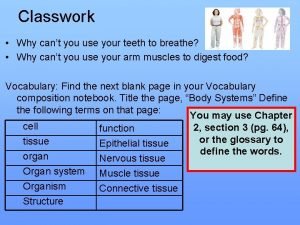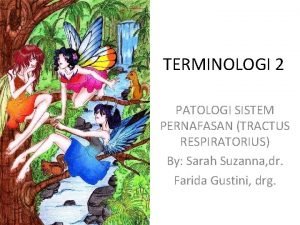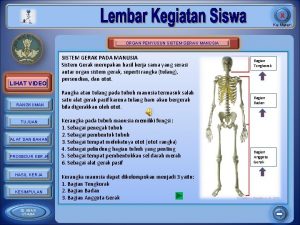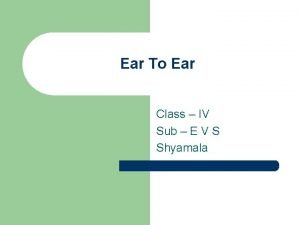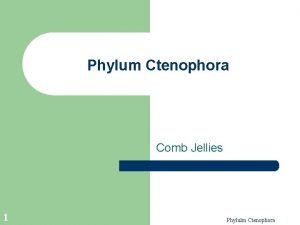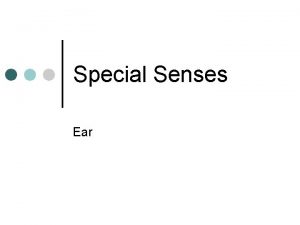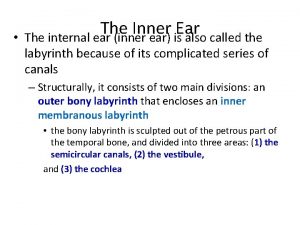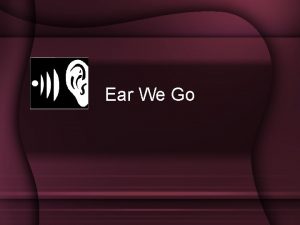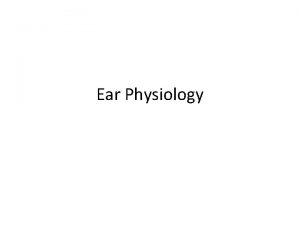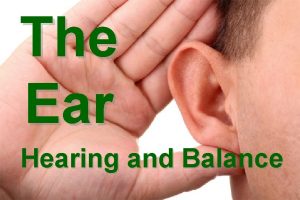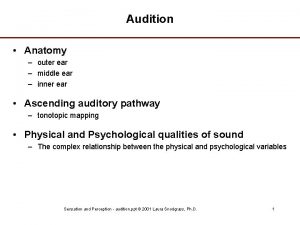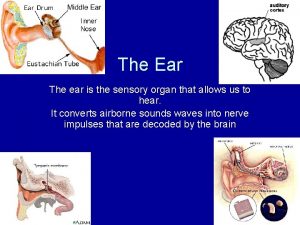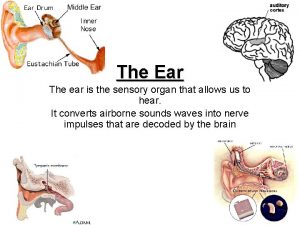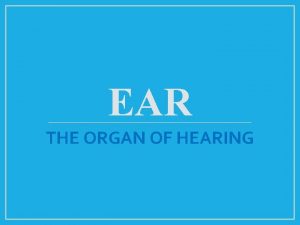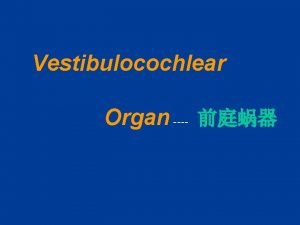EAR The ear is a sense organ for














- Slides: 14


EAR • The ear is a sense organ for hearing and balance • Three main portions of ear – Outer Ear : containing air – Middle ear : containing air – Inner ear : containing fluid • Only mammals contain ear lobes

Parts of ear Structure Function Pinna Fleshy part seen in the side of the head Passage which leads to the eadrum Direct sound waves in to the auditory canal Directs sound wave to he eardrum Auditory canal

Parts of ear Structure Eardrum A thin membrane (tympanum) Function Vibrates when it receive the sound waves and passes the vibration to the ear ossicles Ear ossicles A chain of three small bones Magnify the sound vibrations and connecting the eardrum to the pass them on to the cochlea through oval window the oval window Oval window A thin membrane Transfers the sound vibrations from ear ossicles to the cochlea Round window A thin membrane below the oval window Help sound vibrations to pass through the cochlea Eustachian tube An air passage leading from the middle ear to the throat Helps to equalise the air pressure on each side of the eardrum

Parts of ear Structure Function Cochlea A coiled tube with sensory cells and filled with fluid Changes sound vibrations into nervous impulses for transmission to the brain Auditory nerve A bundle of nerves Carries nervous impulses connecting the cochlea to the from the cochlea to the brain Semicircular canals Three canals containing a fluid which swirls when the head is moved Help the body to maintain balance




Hearing Machanism Pinna- directs sound waves into the auditory canal Auditoty canal- directs sound waves to the eardrum Eardrum- vibrates at the same speed as the sound wave Ear-ossicles- magnify the sound vibrations and make the oval window vibrate at the same frequency

Oval window- vibrates and makes the fluid in the cochlea vibrate Cochlea- changes the sound vibrations into nervous impulses Auditory nerve- transmits the nervous impulses from the cochlea to the brain The brain- interprets the nervous impulses as sounds

Spot test 1. What’s the taste detected by the regions below?

2. State the 2 components which make up the central nervous system. 3. State the 2 types of nerves. 4. State 5 types of receptors in the skin and their function. 5. What’s the 2 factors which affect the sensitivity of the skin? 6. What’s function of the sweat glands in the skin? 7. What is mucus? 8. How can a common cold decrease our sense of smell? 9. Why is the sense of taste called a chemical sense?


 Cell tissue organ organ system organism
Cell tissue organ organ system organism Organ organ pernafasan
Organ organ pernafasan Tissue are grouped together to form various
Tissue are grouped together to form various Organ penyusun sistem indra
Organ penyusun sistem indra Organ penyusun sistem gerak adalah ….
Organ penyusun sistem gerak adalah …. Organ and organ system
Organ and organ system Animals with ears like fan
Animals with ears like fan Pictures of animals whose ears can be seen
Pictures of animals whose ears can be seen Ctenophora digestion
Ctenophora digestion Narrow sense heritability vs broad sense heritability
Narrow sense heritability vs broad sense heritability Narrow sense heritability vs broad sense heritability
Narrow sense heritability vs broad sense heritability Läkarutlåtande för livränta
Läkarutlåtande för livränta Vishnuismen
Vishnuismen Returpilarna
Returpilarna Cks
Cks
